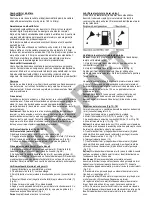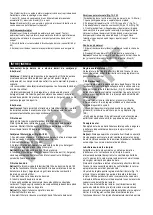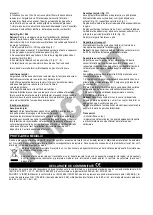
ngers.
Note:
Do not pull hose completely out of tank.
4. Lift fi lter out of tank .
5. Pull off the fi lter with a twist and clean it; if the filter is
damaged, dispose of it.
6. Insert a new fi lter. Place one end of the fi lter into the tank
opening. Make sure that the fi lter is seated in the lower corner of
the tank. If necessary, use a long screwdriver to move the fi lter to
its correct position, taking care not to damage in the process.
7. Fill tank with fresh fuel / oil mixture. See Section Fuel and
Lubrication. Install fuel cap.
Spark plug (Fig. 8A/8B)
Note:
To ensure that the saw’s engine retains its power, the spark
plug must be clean and have the correct electrode gap (0.6 mm).
The spark plug must be cleaned or replaced after every 20 hours
of service.
1. Set the On/Off switch to Stop (0)”.
2. Remove the top cover (14) by undoing the cover fastening
screw (A) on the cover. You can then remove the cover (Fig. 8A).
3. Disconnect the ignition cable (C) from the spark plug by pulling
and twisting it simultaneously (Fig. 8B).
4. Remove the spark plug using a spark plug wrench (Fig. 1C/5).
5. Clean the spark plug with a copper wire brush or fi t a new one.
Turning the screw counter-clockwise increases the chain
lubrication, turning it clockwise decreases the chain
lubrication.
To check the chain lubrication, hold the chain saw, with
the chain, over a piece of paper and run it at full speed
for a few seconds. You will be able to judge the set
amount of oil from the paper. On a regular basis, check
that the chain lubrication is working correctly. Test chain
lubrication before the fi rst cut, after several cuts and
always after any maintenance.
Chain lubrication
Always make sure the automatic oiler system is working
properly. Keep the oil tank fi lled with Chain, Bar and
Sprocket Oil.
Adequate lubrication of the bar and chain during cutting
operations is essential to minimize friction
with the guide bar.
Never starve the bar and chain of lubricating oil.
Running the saw dry or with too little oil will decrease
cutting effi ciency, shorten saw chain life, cause rapid
dulling of chain, and lead to excessive wear of bar from
overheating. Too little oil is evidenced by smoke or bar
discoloration.
Chain maintenance
Chain sharpening
Note:
A sharp chain produces well-defi ned chips. When your
chain starts to produce sawdust, it is time to sharpen.
Chain sharpening requires special tools to ensure that cutters are
sharpened at the correct angle and depth. For the inexperienced
chain saw user, we recommend that the saw chain be
professionally sharpened by the nearest professional Service
Center. If you feel comfortable sharpening your own saw chain,
special tools are available from the professional Service Center.
Chain sharpening (Fig. 11)
Sharpen the chain using protective gloves and a round fi le of.
Always sharpen the cutters only with outward strokes (Fig. 12)
observing the values given in Fig. 11.
After sharpening, the cutting links must all have the same width
and length.
After the blades have been sharpened 3-4 times, check the height
of the depth limiter and if necessary lower it with a fl at fi le and
then round off the front corner (Fig. 13).
Round off the front edges with a file.
Storage and transportation
Install the chain guard (4) before transporting or storing the
chainsaw.
Note:
Never put a chain saw into storage for longer than 30 days
without carrying out the following steps.
Storing a chain saw
Storing a chain saw for longer than 30 days requires
storage maintenance. Unless the storage instructions
are followed, fuel remaining in the carburetor will
evaporate, leaving gum-like deposits.
This could lead to diffi cult starting and result in costly
repairs.
1. Remove the fuel tank cap slowly to release any
pressure in tank. Carefully drain the fuel tank.
2. Start the engine and let it run until the unit stops to
remove fuel from carburetor.
3. Allow the engine to cool (approx. 5 minutes).
4. Thoroughly clean the saw.
Note:
Store the unit in a dry place and away from
possible sources of ignition such as a furnace, gas hot
water heater, gas dryer, etc.
After the saw has been in storage, perform the steps
listed in Paragraph 5 before starting the chainsaw.
Transportation
•
Engage the chain brake.
•
Make sure the chainsaw cannot shift position in order
to prevent fuel loss, damage or injury.
ENVIRONMENT PROTECTION
In order to prevent the machine from damage during transport, it is delivered in a sturdy packaging. Most of the packaging
materials can be recycled. Take these materials to the appropriate recycling locations. Take your unwanted machines to your
local dealer. Here they will be disposed of in an environmentally safe way.
Li-ion batteries can be recycled. Deliver them to a disposal site for chemical waste so that they can be recycled or
disposed of in an environmentally friendly manner.
Discarded electric appliances are recyclable and should not be discarded in the domestic waste! Please actively
support us in conserving resources and protecting the environment by returning this appliance to the collection
centres (if available).
DECLARATION OF CONFORMITY
We declare under our sole responsibility that this product is in conformity with the following standards or standardized
documents: EN ISO 11681-2:2011+A1:17, EN ISO 14982:2009; in accordance with the regulations 2006/42/
EС, 2014/30/EС.
NOISE/VIBRATION Measured in accordance with ISO 22868/ISO 22867 the sound pressure level of this tool is <99,2dB(A) and
the sound power level is <110,4dB(A) (standard deviation: 3 dB), Vibration of front handle is 8,98 m/s
2
, and vibration of rear
handle is 8,03 m/s
2
(K=1,5m/s
2
).
Summary of Contents for CS2600
Page 2: ......
Page 3: ......
Page 4: ......
Page 5: ......
Page 22: ......
Page 39: ......
Page 64: ...Descriere detaliat GCS26 10...
Page 65: ......
Page 80: ...Exploded view GCS26 10...
Page 90: ...Widok rozstrzelony GCS26 10...












































